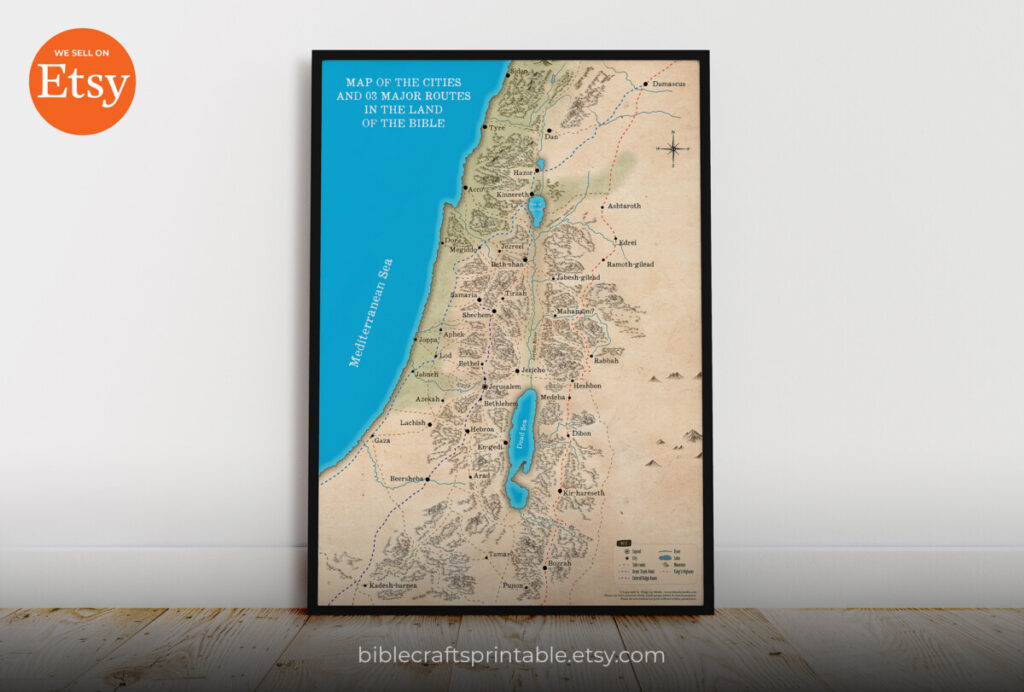The Land of the Bible was a crossroads of ancient civilizations, shaped by vital trade and military routes connecting major cities. Understanding the map of cities & 3 major routes in the Land of the Bible provides valuable insight into biblical history, the movements of key figures, and the significance of geography in ancient times. These routes facilitated commerce, warfare, and religious pilgrimages, making them essential to the development of Israel and surrounding nations.

Key Cities in the Land of the Bible
Throughout biblical history, several cities played critical roles in trade, governance, and religious life. Below are some of the most significant cities found in biblical accounts:
1. Jerusalem
- Importance: The capital of ancient Israel and Judah, home to the Temple of Solomon.
- Biblical Events: King David made it the religious and political center; Jesus was crucified and resurrected here.
- Modern Significance: Remains one of the most sacred cities in Judaism, Christianity, and Islam.
2. Jericho
- Importance: One of the oldest cities in the world, strategically located near the Jordan River.
- Biblical Events: The walls of Jericho famously fell when the Israelites conquered it under Joshua.
3. Bethlehem
- Importance: Birthplace of King David and Jesus Christ.
- Biblical Events: The location of the nativity story in the Gospels.
4. Hebron
- Importance: A significant city in the history of the patriarchs.
- Biblical Events: Abraham purchased the Cave of Machpelah as a burial site for his family.
5. Samaria
- Importance: Capital of the northern Kingdom of Israel.
- Biblical Events: The city became a center of idol worship under Ahab and Jezebel.
6. Capernaum
- Importance: A central location in Jesus’ ministry.
- Biblical Events: Jesus performed many miracles here, including healing the centurion’s servant.
7. Caesarea Maritima
- Importance: A Roman-built port city on the Mediterranean coast.
- Biblical Events: Paul was imprisoned here before being sent to Rome.
8. Damascus
- Importance: An ancient trade city and a key location in early Christianity.
- Biblical Events: Paul’s conversion occurred on the Road to Damascus.
9. Nineveh
- Importance: The capital of the Assyrian Empire.
- Biblical Events: The prophet Jonah was sent to call the city to repentance.
10. Tyre & Sidon
- Importance: Major Phoenician cities known for trade and wealth.
- Biblical Events: Jesus visited this region and performed miracles.
These cities were connected by extensive trade and military routes, which played a significant role in shaping biblical history.

The 3 Major Routes in the Land of the Bible
The geography of the ancient Near East required well-established roads to facilitate movement between Egypt, Mesopotamia, and the Levant. The three major routes in biblical times were:
1. The Via Maris (The Way of the Sea)
- Location: A coastal highway running from Egypt through Canaan to Mesopotamia.
- Significance:
- One of the oldest and most important trade routes.
- Controlled by various empires, including Egypt, Assyria, and Rome.
- Mentioned in Isaiah 9:1 as the “Way of the Sea.”
- Cities Along the Route: Gaza, Ashdod, Joppa, Caesarea, Tyre, Sidon, and Damascus.
- Biblical Connections: Jesus traveled through parts of this route during His ministry.
2. The King’s Highway
- Location: An inland route running north-south through the Transjordan region.
- Significance:
- Used by Abraham, Moses, and the Israelites.
- Served as a major caravan route for trade and military movements.
- Cities Along the Route: Edom, Moab, Ammon, Gilead, and Damascus.
- Biblical Connections:
- Numbers 20:17-21 describes Moses requesting passage through Edom via this route.
- The Ammonites and Moabites controlled sections of this highway.
3. The Ridge Route (Central Mountain Highway)
- Location: A road running through the central highlands of Israel.
- Significance:
- Provided direct access to the hill country, including Jerusalem.
- Used primarily for local travel and defense.
- Cities Along the Route: Hebron, Bethlehem, Jerusalem, Bethel, and Shechem.
- Biblical Connections:
- King David used this route when fleeing from Saul.
- Many of the patriarchs, including Abraham and Jacob, traveled along this road.
The Importance of These Routes in Biblical History
These three major routes played a significant role in shaping biblical events and interactions between nations. They allowed for:
- Trade and Economic Growth – Connected Egypt, Mesopotamia, and the Levant, facilitating the exchange of goods and ideas.
- Military Campaigns – Used by empires like Assyria, Babylon, Rome, and Egypt for conquest and control.
- Religious Pilgrimages – Enabled people to travel to Jerusalem for feasts and worship.
- Divine Encounters – Many biblical figures, including Abraham, Moses, and Paul, traveled these routes during pivotal moments in history.
FAQs
Why was the Via Maris important in biblical times?
The Via Maris connected major civilizations, serving as a crucial trade and military route mentioned in biblical prophecy.
Did Jesus travel on these routes?
Yes, Jesus likely traveled along sections of the Via Maris and Ridge Route during His ministry in Galilee and Jerusalem.
Which route did Moses and the Israelites take during the Exodus?
Moses sought to travel via the King’s Highway, but the Edomites refused passage, forcing the Israelites to take a longer route.
How did these routes influence biblical battles?
Major battles, such as those between the Israelites and the Philistines, took place near these roads due to their strategic importance.
What cities on these routes are still inhabited today?
Cities like Jerusalem, Damascus, Tyre, and Sidon still exist and hold great historical and religious significance.
Conclusion
The Map of Cities & 3 Major Routes in the Land of the Bible offers profound insights into how geography influenced biblical events. These roads connected the ancient world, shaping trade, military campaigns, and the movements of key biblical figures. Understanding these cities and routes enhances our appreciation of biblical history and the intricate way God used geography to fulfill His divine plan.
